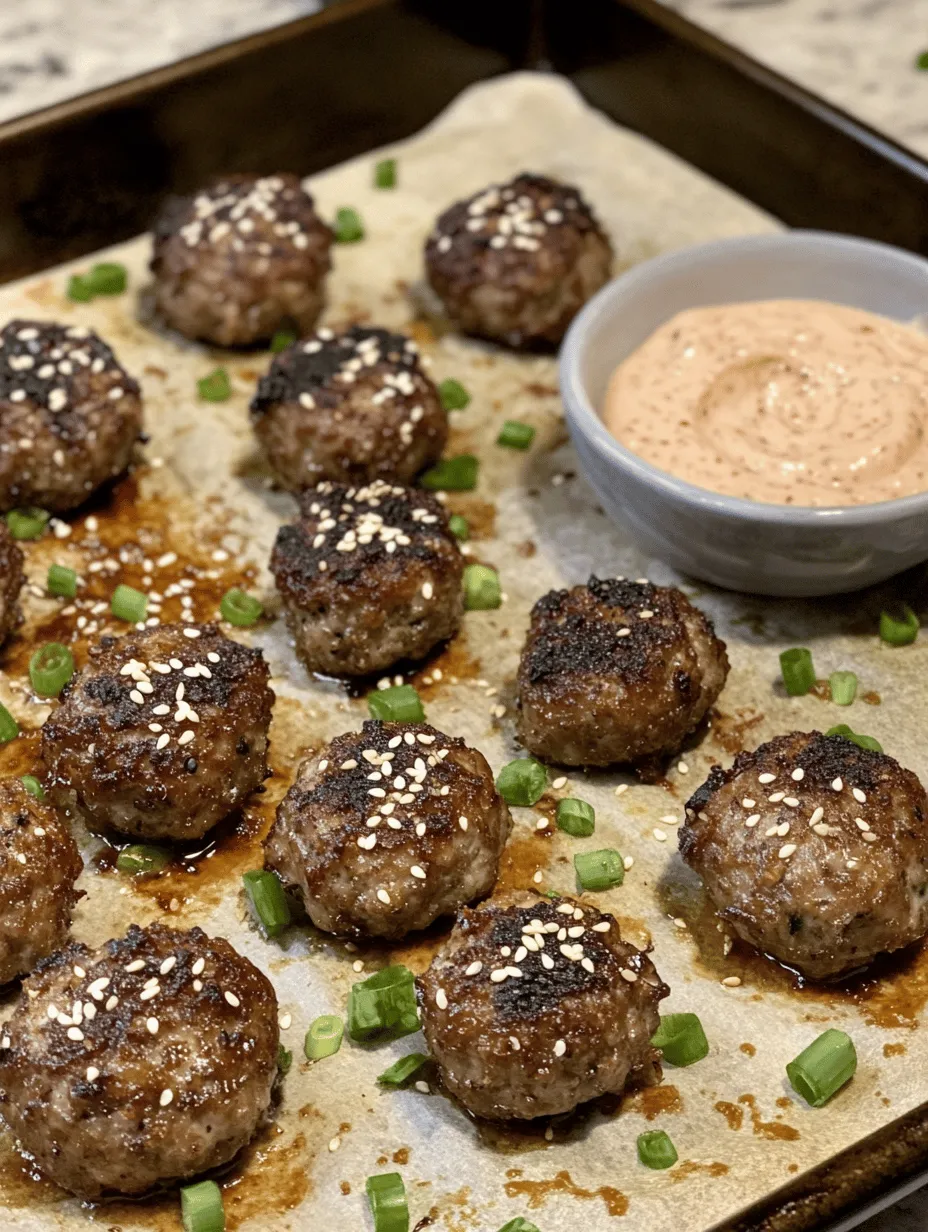Introduction
Korean cuisine has seen a meteoric rise in global popularity over the past few years, enthralling food lovers with its vibrant flavors, aromatic spices, and unique cooking techniques. From the sizzling sound of bulgogi on a grill to the rich, fermented taste of kimchi, Korean dishes offer an exciting tapestry of culinary experiences. Among the plethora of delicious options, Korean BBQ meatballs stand out as a delightful fusion of traditional Korean flavors and universally loved comfort food.
Korean BBQ meatballs are not just an ordinary dish; they embody a perfect blend of savory, sweet, and spicy flavors, all wrapped up in a tender, juicy meatball. The addition of a spicy mayo dip elevates this dish further, adding a creamy, zesty element that balances the umami-rich meat. Their versatility is another appealing aspect—these meatballs can serve as a crowd-pleasing appetizer at parties, a delightful snack for game day, or even a hearty main course when paired with rice and vegetables.
Understanding Korean BBQ
The Korean BBQ experience is more than just a meal—it’s a cultural event that emphasizes social interaction and communal dining. Traditionally, diners gather around a grill, where they cook marinated meats such as bulgogi (marinated beef) or galbi (marinated short ribs) right at the table. This interactive style of dining encourages camaraderie, making every meal a joyous occasion.
While meatballs may not be the first dish that comes to mind when thinking of Korean BBQ, they hold a significant place in the culinary landscape. In Korea, meatballs are often made using ground meat, vegetables, and spices, showcasing the country’s knack for creating flavorful, bite-sized dishes. These meatballs are not only easy to prepare but also adaptable, allowing chefs to incorporate various ingredients based on personal preferences or regional variations.
Korean cooking is rooted in the use of fresh, high-quality ingredients. Common staples include soy sauce, sesame oil, garlic, ginger, and an array of vegetables. These ingredients work in harmony to create the bold flavors that define Korean cuisine. Korean BBQ meatballs take these foundational elements and transform them into a dish that appeals to both traditionalists and modern foodies alike.
Ingredients Breakdown
To create the perfect Korean BBQ meatballs, it’s essential to understand the role of each ingredient involved in the recipe. Here’s a detailed breakdown of the components that contribute to the dish’s unique flavor profile:
Ground Beef vs. Pork
When it comes to the choice of meat for your meatballs, both ground beef and pork are popular options in Korean cuisine. Ground beef offers a rich, hearty flavor and a firmer texture, making it an excellent base for meatballs. On the other hand, ground pork provides a slightly sweeter taste and a juicier texture due to its higher fat content. Depending on your preference, you can use one or a combination of both to achieve the desired flavor and moisture in your meatballs.
The Role of Cooked Rice
A key ingredient in Korean meatballs is cooked rice, which serves several purposes. First, it acts as a binder, helping to hold the meat mixture together while adding moisture. Additionally, the rice enhances the meatballs’ texture, ensuring they remain tender and not overly dense. Using short-grain rice, commonly found in Korean dishes, will yield the best results, as it has a stickier consistency that helps to bond the ingredients.
Fresh Herbs and Aromatics
To infuse your meatballs with authentic Korean flavor, incorporating fresh herbs and aromatics is a must. Green onions, garlic, and ginger are frequently used in Korean cooking and lend a fragrant aroma and depth of flavor to the meatball mixture. Green onions provide a mild onion flavor and a pop of color, while garlic and ginger add warmth and spice, creating a well-rounded taste.
Flavor Enhancers: Soy Sauce, Sesame Oil, and Brown Sugar
No Korean dish would be complete without the signature flavors of soy sauce, sesame oil, and brown sugar. Soy sauce is a staple in Korean cooking and provides umami richness and saltiness. Sesame oil adds a nutty, aromatic quality that enhances the overall flavor profile. Brown sugar balances the savory notes with sweetness, creating a harmonious blend that characterizes Korean cuisine.
Ingredients for the Spicy Mayo Dip
To accompany the meatballs, a spicy mayo dip is the perfect complement. The base of this dip is mayonnaise, which offers a creamy texture and rich flavor. By mixing in sriracha, you introduce a spicy kick that pairs beautifully with the meatballs. Lime juice adds a refreshing acidity that cuts through the richness of the mayo, while garlic powder enhances the flavor with a subtle garlic note.
Optional Garnishes
Presentation plays an important role in the enjoyment of a meal, and adding garnishes can elevate your dish visually. Optional garnishes for Korean BBQ meatballs may include chopped green onions, sesame seeds, or even a sprinkle of crushed red pepper flakes for an extra burst of heat. These garnishes not only enhance the appearance of your dish but also contribute additional flavors that will leave your guests wanting more.
Preparation Steps for Korean BBQ Meatballs
Now that you have a clear understanding of the ingredients and their roles, it’s time to dive into the preparation process for your Korean BBQ meatballs. Below is a detailed guide to preparing the meatball mixture and ensuring that your meatballs turn out tender and flavorful.
Preparing the Meatball Mixture
1. Gather Your Ingredients: Before you begin, ensure that all your ingredients are measured and ready to use. This includes your choice of ground meat, cooked rice, chopped green onions, minced garlic, grated ginger, soy sauce, sesame oil, brown sugar, and any other seasonings you plan to use.
2. Combine the Ingredients: In a large mixing bowl, combine the ground meat with the cooked rice, chopped green onions, minced garlic, grated ginger, soy sauce, sesame oil, and brown sugar. Use your hands or a spatula to gently mix the ingredients together. Be careful not to overmix, as this can lead to dense meatballs. The goal is to combine the ingredients until just incorporated.
3. Assess the Mixture’s Consistency: After mixing, check the consistency of your meatball mixture. It should be moist and hold together when formed into balls. If the mixture feels too dry, consider adding a splash more soy sauce or a little water to help bind it. If it’s too wet, you can add a small amount of breadcrumbs or additional cooked rice.
4. Chill the Mixture (Optional): For easier handling, you can refrigerate the meatball mixture for about 30 minutes. This step helps to firm up the mixture, making it easier to shape into meatballs.
5. Shape the Meatballs: Once the mixture is ready, use your hands to form the meatballs. Aim for uniform sizes—about 1 to 1.5 inches in diameter is ideal. This ensures even cooking and allows for a consistent texture throughout.
Importance of Ingredient Temperature and Mixing Techniques
When preparing meatballs, the temperature of your ingredients can significantly impact the final product. For optimal results, ensure that your ground meat is cold when mixing. This helps to retain moisture during cooking and prevents the meat from becoming tough.
Additionally, the technique of mixing is crucial. Use a light touch to combine the ingredients, as overmixing can lead to a dense texture. The key is to incorporate everything just until combined, allowing the flavors to meld without compromising the meat’s natural tenderness.
Tips for Achieving Tender Meatballs
– Don’t Overmix: As mentioned earlier, overmixing can lead to tough meatballs. Mix just until the ingredients are combined.
– Use Fresh Ingredients: Fresh herbs and aromatics pack more flavor than dried alternatives, ensuring that your meatballs are vibrant and delicious.
– Experiment with Seasonings: Feel free to adjust the seasonings to your taste. If you enjoy a little more heat, add extra sriracha to the meat mixture. If you prefer a sweeter profile, increase the amount of brown sugar.
– Cook a Test Meatball: Before cooking the entire batch, consider frying a small test meatball to check for seasoning and texture. This allows you to make any necessary adjustments before cooking the rest.
Following these steps and tips will set you on the path to creating flavorful, tender Korean BBQ meatballs ready to be paired with a spicy mayo dip. The next step will involve the cooking process, where you’ll learn how to achieve the perfect cook on your meatballs, but that will be covered in the next part of the article. Stay tuned!

Step-by-Step Instructions on Forming and Baking the Meatballs
To create delicious Korean BBQ meatballs, start by preheating your oven to 400°F (200°C). This temperature ensures that the meatballs cook thoroughly while developing a beautiful, caramelized exterior.
Forming the Meatballs
1. Prepare Your Mixture: In a large mixing bowl, combine your ground meat (beef, pork, or a mix), breadcrumbs, chopped green onions, minced garlic, grated ginger, soy sauce, sesame oil, and any other seasonings you’ve opted for. Use your hands or a spatula to mix the ingredients gently; avoid overmixing, which can make the meatballs tough.
2. Shape the Meatballs: Once your mixture is well combined, take a small amount (about 1.5 inches in diameter) and roll it into a ball between your palms. The perfect meatball should be firm yet tender, which helps it hold its shape during cooking.
3. Placement on Baking Sheet: Line a baking sheet with parchment paper for easy cleanup. Place the meatballs on the sheet, ensuring they are spaced about 1 inch apart. This spacing allows for even cooking and helps prevent them from sticking together.
4. Baking the Meatballs: Bake the meatballs in your preheated oven for 20-25 minutes, or until they reach an internal temperature of 160°F (71°C) for ground beef or pork. If you desire an extra layer of flavor, consider broiling the meatballs for an additional 2-3 minutes at the end of the baking time. Keep a close eye on them during broiling to avoid burning.
Best Practices for Meatball Shaping and Spacing on the Baking Sheet
When shaping meatballs, consistency is key. Aim for uniformity in size so they cook evenly. Use a cookie scoop or measuring spoon to help achieve this, making the process quicker and more precise.
Space the meatballs adequately on the baking sheet to ensure air can circulate around them. This will not only help them cook evenly but also allow for that desirable browning.
Understanding Baking Times and the Option for Broiling for Added Flavor
Baking times may vary slightly depending on your oven and the size of your meatballs. Always use a meat thermometer to check for doneness. For an even more enticing flavor, broiling at the end of the bake can enhance the caramelization, giving the meatballs a delicious charred finish. Just remember to watch them closely as they can go from perfectly browned to burnt quite quickly under the broiler.
Crafting the Spicy Mayo Dip
While your meatballs are baking, you can prepare the spicy mayo dip. This creamy, spicy accompaniment complements the savory flavors of the meatballs perfectly.
Step-by-Step Instructions on Preparing the Dip
1. Gather Your Ingredients: You will need mayonnaise, Sriracha sauce (or another hot sauce), lime juice, and a pinch of salt. For an added kick, consider incorporating garlic powder or sesame oil.
2. Mix the Ingredients: In a small bowl, combine ½ cup of mayonnaise with 2-3 tablespoons of Sriracha, depending on your heat preference. Add a squeeze of lime juice and a small pinch of salt.
3. Adjust for Spice Levels: Taste the dip and adjust the spice levels to your liking. Adding more Sriracha will increase the heat, while additional mayonnaise can tone it down.
4. Achieving the Perfect Consistency and Flavor Balance: If you prefer a thinner consistency, slowly add a little water or more lime juice until you reach your desired thickness. Keep adjusting the seasoning until it’s perfectly balanced—creamy, spicy, and tangy.
5. Suggestions for Variations or Additions to the Dip: For a unique twist, consider adding chopped scallions, sesame seeds, or even a splash of soy sauce. These adjustments will enhance the flavor profile and make your dip even more exciting.
Serving Suggestions
Korean BBQ meatballs can be enjoyed in various ways, making them a versatile dish for any occasion.
Ideas for Serving the Meatballs as Appetizers or Main Dishes:
– As Appetizers: Serve the meatballs on skewers or toothpicks with the spicy mayo dip on the side for easy snacking at parties or gatherings. Garnish with sesame seeds and sliced green onions for added flair.
– As Main Dishes: Present the meatballs over a bed of steamed rice or noodles, drizzled with extra spicy mayo. This transforms the dish into a hearty meal that is both satisfying and delicious.
Pairing Recommendations with Traditional Korean Sides:
Pair your meatballs with traditional Korean sides like kimchi, pickled radishes, or a fresh salad for a balanced meal. These side dishes will enhance the overall experience and provide a refreshing contrast to the rich flavors of the meatballs.
Presentation Tips for an Appetizing Setup:
Use a large platter for serving and arrange the meatballs neatly. Drizzle the spicy mayo dip artistically over the meatballs or serve it in a small bowl for dipping. Adding fresh herbs or edible flowers can elevate the presentation, making it visually appealing.
Health and Nutritional Aspects
When considering the health implications of your Korean BBQ meatballs and spicy mayo dip, it’s essential to evaluate both the ingredients and the overall nutritional balance.
Nutritional Overview of the Meatballs and Dip:
– Protein: The meatballs are an excellent source of protein, essential for muscle repair and growth.
– Carbohydrates: The inclusion of breadcrumbs adds some carbs, but you can opt for whole grain options for additional fiber.
– Fats: While the dip contains fat from mayonnaise, you can choose light mayonnaise or Greek yogurt as a healthier alternative.
Discussion on the Balance of Protein, Carbohydrates, and Fats in the Recipe:
This recipe provides a well-rounded meal, with protein from the meat, carbohydrates from the breadcrumbs and rice, and healthy fats from the dip. Balancing these macronutrients is key to a nutritious meal.
Options for Healthier Substitutes:
To make the dish lighter, consider using ground turkey or chicken instead of pork or beef. You can also substitute with leaner cuts of meat to reduce fat content. For the dip, Greek yogurt can replace mayonnaise, offering a tangy flavor and added protein without the extra calories.
Cultural Significance of the Dish
Korean BBQ meatballs are more than just a delicious recipe; they reflect the rich culinary traditions of Korea.
Exploration of the Cultural Importance of Meatballs in Korean Cuisine:
In Korean culture, meat dishes often symbolize abundance and celebration. Meatballs, although not as traditional as other dishes, have become popular in modern Korean cuisine, especially among younger generations who enjoy fusion dishes.
How This Dish Reflects the Communal Aspect of Korean Dining:
Korean dining is centered around sharing and community. Serving meatballs encourages this communal experience, as they can be enjoyed in a family-style setting, where everyone can partake and customize their meal.
Discussion on the Fusion of Flavors and How It Appeals to Diverse Palates:
The combination of sweet, savory, and spicy flavors in Korean BBQ meatballs appeals to a wide audience, transcending cultural boundaries. This fusion reflects the adaptability of Korean cuisine and its ability to resonate with various tastes around the world.
Conclusion
In summary, Korean BBQ meatballs with spicy mayo dip bring together a delightful blend of flavors and textures that are sure to impress. From the detailed process of forming and baking the meatballs to crafting the perfect spicy dip, every aspect of this recipe celebrates the joy of cooking.
Whether served as an appetizer at a gathering or as a main dish alongside traditional Korean sides, these meatballs encapsulate the spirit of Korean dining—communal, flavorful, and enjoyable. Embrace the journey of culinary exploration and share this delightful dish with loved ones, allowing the flavors of Korea to grace your table.



